安全工程中英文翻译资料
- 格式:pdf
- 大小:256.76 KB
- 文档页数:14
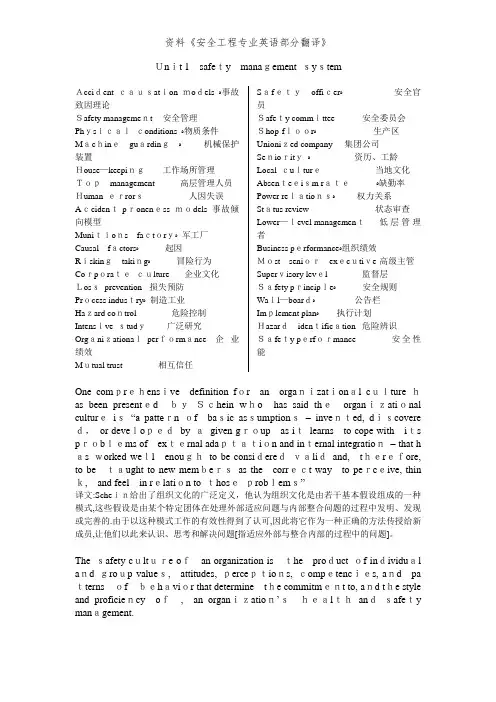
Unit 1safety management systemAccident causation models ﻩ事故致因理论Safety management 安全管理Physicalconditions ﻩ物质条件Machineguardingﻩ机械保护装置House—keeping工作场所管理Topmanagement 高层管理人员Human errors人因失误Accident-proneness models 事故倾向模型Munitions factoryﻩ军工厂Causal factorsﻩ起因Riskingtakingﻩ冒险行为Corporateculture 企业文化Lossprevention 损失预防Process industryﻩ制造工业Hazard control 危险控制Intensive study广泛研究Organizationalperformance 企业绩效Mutual trust 相互信任Safetyofficerﻩ安全官员Safety committee 安全委员会Shop-floorﻩ生产区Unionized company 集团公司Seniorityﻩ资历、工龄Local culture当地文化Absenteeism rateﻩ缺勤率Power relationsﻩ权力关系Status review 状态审查Lower—level management低层管理者Business performanceﻩ组织绩效Most seniorexecutive 高级主管Supervisory level监督层Safety principleﻩ安全规则Wall—boardﻩ公告栏Implement planﻩ执行计划Hazardidentification 危险辨识Safety performance 安全性能One comprehensive definition for an organizational culture has been presentedbySchein who has said theorganizational cultureis“a pattern of basic assumptions–invented, discovere d,or developedby agiven group as itlearns to cope with its problems of external adaptation and internal integration– that h as worked well enoughto be consideredvalidand,therefore, to betaught to new membersas the correct way to perceive, thin k,and feel in relation to thoseproblems”译文:Schein给出了组织文化的广泛定义,他认为组织文化是由若干基本假设组成的一种模式,这些假设是由某个特定团体在处理外部适应问题与内部整合问题的过程中发明、发现或完善的.由于以这种模式工作的有效性得到了认可,因此将它作为一种正确的方法传授给新成员,让他们以此来认识、思考和解决问题[指适应外部与整合内部的过程中的问题]。
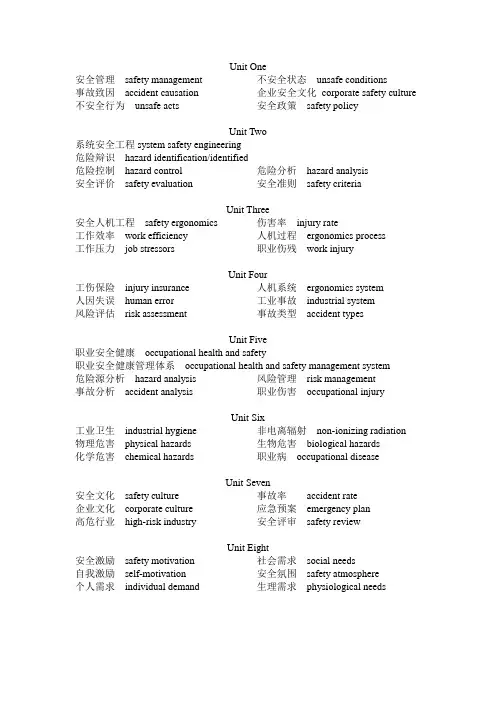
Unit One安全管理safety management 事故致因accident causation 不安全行为unsafe acts不安全状态unsafe conditions企业安全文化corporate safety culture安全政策safety policyUnit Two系统安全工程system safety engineering 危险辩识hazard identification/identified危险控制hazard control 安全评价safety evaluation危险分析hazard analysis安全准则safety criteria Unit Three安全人机工程safety ergonomics 工作效率work efficiency工作压力job stressors伤害率injury rate人机过程ergonomics process职业伤残work injuryUnit Four工伤保险injury insurance 人因失误human error风险评估risk assessment人机系统ergonomics system工业事故industrial system事故类型accident types Unit Five职业安全健康occupational health and safety职业安全健康管理体系occupational health and safety management system危险源分析hazard analysis 事故分析accident analysis风险管理risk management职业伤害occupational injury Unit Six工业卫生industrial hygiene 物理危害physical hazards 化学危害chemical hazards非电离辐射non-ionizing radiation生物危害biological hazards职业病occupational diseaseUnit Seven安全文化safety culture企业文化corporate culture 高危行业high-risk industry事故率accident rate应急预案emergency plan安全评审safety review Unit Eight安全激励safety motivation 自我激励self-motivation个人需求individual demand 社会需求social needs安全氛围safety atmosphere 生理需求physiological needs。
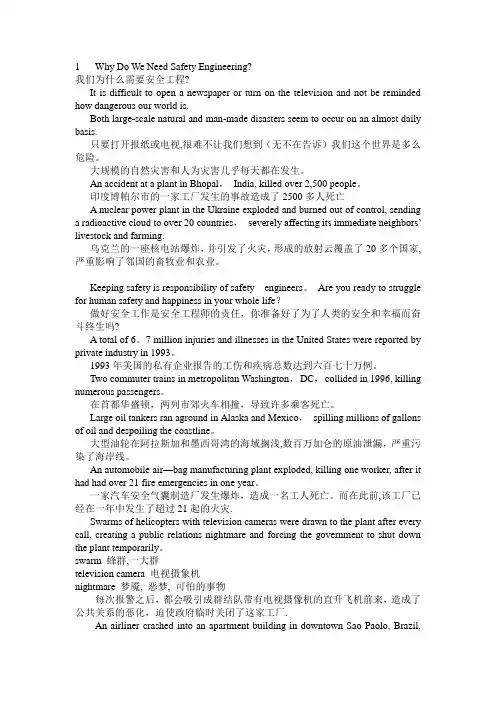
1 Why Do We Need Safety Engineering?我们为什么需要安全工程?It is difficult to open a newspaper or turn on the television and not be reminded how dangerous our world is.Both large-scale natural and man-made disasters seem to occur on an almost daily basis.只要打开报纸或电视,很难不让我们想到(无不在告诉)我们这个世界是多么危险。
大规模的自然灾害和人为灾害几乎每天都在发生。
An accident at a plant in Bhopal,India, killed over 2,500 people。
印度博帕尔市的一家工厂发生的事故造成了2500多人死亡A nuclear power plant in the Ukraine exploded and burned out of control, sending a radioactive cloud to over 20 countries,severely affecting its immediate neighbors’ livestock and farming.乌克兰的一座核电站爆炸,并引发了火灾,形成的放射云覆盖了20多个国家,严重影响了邻国的畜牧业和农业。
Keeping safety is responsibility of safety engineers。
Are you ready to struggle for human safety and happiness in your whole life?做好安全工作是安全工程师的责任,你准备好了为了人类的安全和幸福而奋斗终生吗?A total of 6。
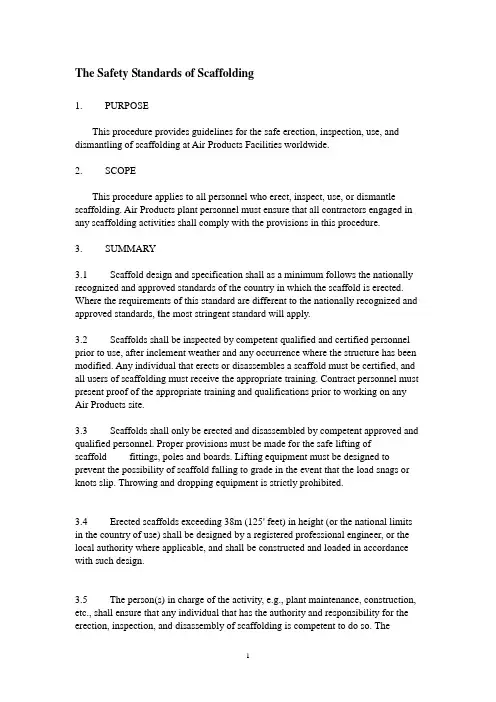
The Safety Standards of Scaffolding1. PURPOSEThis procedure provides guidelines for the safe erection, inspection, use, and dismantling of scaffolding at Air Products Facilities worldwide.2. SCOPEThis procedure applies to all personnel who erect, inspect, use, or dismantle scaffolding. Air Products plant personnel must ensure that all contractors engaged in any scaffolding activities shall comply with the provisions in this procedure.3. SUMMARY3.1 Scaffold design and specification shall as a minimum follows the nationally recognized and approved standards of the country in which the scaffold is erected. Where the requirements of this standard are different to the nationally recognized and approved standards, t he most stringent standard will apply.3.2 Scaffolds shall be inspected by competent qualified and certified personnel prior to use, after inclement weather and any occurrence where the structure has been modified. Any individual that erects or disassembles a scaffold must be certified, and all users of scaffolding must receive the appropriate training. Contract personnel must present proof of the appropriate training and qualifications prior to working on any Air Products site.3.3 Scaffolds shall only be erected and disassembled by competent approved and qualified personnel. Proper provisions must be made for the safe lifting ofscaffold fittings, poles and boards. Lifting equipment must be designed to prevent the possibility of scaffold falling to grade in the event that the load snags or knots slip. Throwing and dropping equipment is strictly prohibited.3.4 Erected scaffolds exceeding 38m (125' feet) in height (or the national limits in the country of use) shall be designed by a registered professional engineer, or the local authority where applicable, and shall be constructed and loaded in accordance with such design.3.5 The person(s) in charge of the activity, e.g., plant maintenance, construction, etc., shall ensure that any individual that has the authority and responsibility for the erection, inspection, and disassembly of scaffolding is competent to do so. Theindividual will be deemed competent after receiving suitable training by an approved scaffold training company or in-house expert and shall be documented.3.6 Scaffolds shall have guardrails, mid-rails, and toe boards installed on all open sides and ends of platforms.3.6.1 Guardrails shall be installed no less than 970 mm (38" inches) or not more than 1,140 mm (45" inches) high with a mid-rail, or as required by the National Standard. There must not be a gap between guardrails, or between toe boards and guardrails, greater than 470 mm (18" inches).3.6.2 Toe boards shall be a minimum of 102 mm (4" inches) in height and must be secured to prevent movement. Toe boards are to be of wood construction, aluminum, or steel preformed to match the scaffold.3.6.3 In windy conditions and certain situations, netting must be placed between the toe board and mid-rails (and top rails in some cases) to prevent materials, i.e. paper, rags, small tools; various materials from being blown off the scaffold decking and falling onto the ground exposing people below to fall hazards.3.7 Scaffolds must be erected on sound surfaces and base plates must be used at all times. Footing or anchorage for scaffolds shall be rigid, and capable of carrying the maximum intended load without settling or displacement. Unstable objects such as barrels, boxes, loose brick or concrete blocks shall not be used to support scaffolds. 3.8 All poles, legs, or uprights of scaffolds shall be plumb and rigidly braced to prevent swaying and displacement. Sufficient ties or raking shores shall be provided to ensure that the scaffold cannot fall away from the object being scaffolded.3.9 Scaffold surfaces shall be kept clean and free from sharp edges, burrs, or other safety hazards.3.10 Scaffolds shall not be loaded in excess of the working load for which they are intended. Scaffolds and their components shall be capable of supporting at least four (4) times the maximum intended load. Scaffolds should have their safe working loads posted or visible to those working who will be performing work on the scaffold.3.11 Scaffold work platforms shall be fully planked with wood, aluminum, or steel scaffold planks or 51 mm X 254 mm (2" x 10" inches) lumber that meets Planking Requirements and is rated to support the intended load.3.12 Scaffolds shall be maintained in a safe condition, and shall only be altered by competent approved and qualified personnel. Scaffolds undergoing modification shall be withdrawn from use until the modification work has been completed, and the scaffold inspected and approved for use by a competent approved and qualified person.3.13 Scaffolds (including mobile access towers) shall not be moved while they are in use or occupied.3.14 Scaffolds damaged or part weakened from any cause shall immediately be replaced and shall not be used until repairs have been completed and the scaffoldre-inspected.3.15 The preferred method of access and egress to a work platform is from a ladder which shall be fitted with an access gate panel. Chain gates can only be used where access gate panels are not safely accessible. Access ladders should not exceed9m (30' feet) in length, and shall extend a min. of 1.1m (3.5' feet) past the working platform.3.16 Access ladder(s) shall be provided with each scaffold built. Access ladders must be of an approved construction, fixed on a suitable foundation, and unpainted. The ladders should be fixed at the top, bottom, and sufficient intermediate points to prevent undue sagging or movement. The recommended gradient is to be 1:4(i.e., about 1 unit out for every 4 units in height). A chain gate shall be used on ladder frames when access gate panels are not safely accessible.3.17 Access or working platforms shall be no more than 9m (30' feet) apart vertically. When a scaffold height exceeds 9 m (30' feet) all additional platforms shall be on the inside of the scaffolding. If the working platforms are spaced more than6.1m (20' feet)) apart, the ladders shall then be equipped either self- retracting lifelines or an OSHA or equivalent National approved cage. The lifeline shall be installed to an acceptable anchorage point capable to withstand 2300Kgs or (5000 Lbs) per individual attached for fall protection. Any ladder over7.3m (24' feet) or 9.1m (30' feet) must have an intermediate platform as a means for resting on the way up.3.18 Use of pulleys, hoist arms, or other devices to hoist material is prohibited, unless the scaffold is guyed or braced to a permanent structure to prevent tipping or has been designed to accommodate these lifting devices.3.19 Use of ladders or makeshift devices on top of scaffold to increase its heightor to provide access from above is prohibited.4. PROCEDURE4.1 Safety Considerations4.1.1 Depending on the nature and the area of work, appropriate personal protective equipment must be worn by personnel. A competent person must determine the feasibility and safety, or where National Standards may dictate, of providing fall protection during the erection and dismantling of scaffolding.Note: Fall protection must be worn by workers erecting and dismantling scaffolds when exposed to falls greater than 6 feet.4.1.2 Personnel working on a scaffold platform with full handrail, mid rail, toe boards and gated access are not required to tie off when working inside the platform area. Safety harness shall be used during scaffold erection. Tie off is required above 2m (6' feet).4.1.3 Personal protective equipment must be used which has been identified through the Workplace Risk Assessment/Job Safety Analysis.4.1.4 Scaffolds shall be built or dismantled in a manner to prevent passage from under the scaffold. Caution tape should be used to mark a safe zone around the scaffolds. Personnel access through mid rails and cross bracing is not recommended.4.1.5 If a scaffold erection interferes with the permanent access ladder or permanent fall protection device, alternative fall protection and ladder access must be provided.4.1.6 Special precautions shall be taken to protect scaffold structure including any wire or fiber ropes when using a heat producing process.4.1.7 Falling objects protection must be installed to provide protection from falling hand tools, debris, and other small objects. This can be accomplished by using toe boards, screens or brick guards; guard rails systems, nets, catch platforms, or canopy structure methods. These systems must be capable of containing or deflecting falling objects. Overhead protection shall be provided for individuals working on a scaffold exposed to overhead hazards.4.1.8 Individuals shall not work on scaffolds during a storm or high winds. Every effort should be made to exit the scaffold prior to electrical storms. Scaffolds should only be sheeted in where the scaffold structure (including ties and/or raking shores) has been specifically designed to accommodate the additional wind loads that thisimposes.4.1.9 Individuals shall not work on scaffolding, which is covered with ice or snow, unless all ice or snow is removed and planking is covered with antiskid material to prevent slipping. This is because the deadweight of ice and snow can lead to significant overloading of the scaffold structure.4.1.10 Tools, materials, and debris shall not be allowed to accumulate in quantities to cause a hazard.4.1.11 Partly erected/dismantled scaffold must have suitable warning signs posted in prominent locations, be barricaded off, or policed to prevent unauthorized entry. The use of Scaffold tags is strongly recommended.4.1.12 When scaffold material is stored on-site, it is advisable to store the material under dry conditions.4.1.13 Scaffolds are not to be placed closer than 9m (30' feet) to live power lines, or no closer than the minimum clearance specified by the National Electrical Safety guidelines in the country of jurisdiction. In some countries grounding of the scaffold structure is required.4.1.14 Scaffold accessories shall be used and installed in accordance with manufacturer's recommended procedures. Accessories shall not be altered in the field.4.1.15 Personnel who perform work on scaffolding systems must be trained according to the requirements outlined by Air Products or according to national or local regulations. Retraining is required in at least in the following situations:4.1.15.1 Where changes at the worksite present a hazard about which any employee has not been previously trained.4.1.15.2 Where changes in the types of scaffolds, fall protection, falling object protection, or other equipment present a hazard about which an employee has not been previously trained.4.1.15.3 Where inadequacies in an affected employee's work involving scaffolding indicates that the employee has not retained the requisite proficiency.4.1.15.4 Where changes to the procedure have taken place, which an employee has not been previously trained.Note: The Following Environmental Considerations:Metal scaffold platforms should be used during Lead Abatement Activitieswhenever possible, to eliminate contamination and cleanup of wood walk boards.4.2 Scaffold Inspection4.2.1 Scaffolding shall be inspected by a competent, qualified and certified scaffold inspector prior to use, after any modification, or after any occurrence which could affect the integrity of the scaffold structure. This shall either be the contractor responsible for the provision of the scaffold or an Air Products employee trained in the proper erection, inspection and use of scaffolding. The results and periodic frequency of such inspections shall be recorded and Scaffold Tags posted in a prominent location at each access point to show the inspection status of the scaffold and next inspection period.The periodic frequency shall depend on factors such as the type of scaffold, site and weather conditions, intensity of use, age of the equipment, and how often sections or components are added, removed or changed, but should never exceed 1 week (7 days). These kinds of factors will determine how quickly or how slowly safety related faults, loose connections, degradation and other defects could be expected to develop, and consequently indicate whether inspections should be conducted more frequently than every 7 days.4.2.1.1 For routine maintenance activities, all scaffolding shall be inspected daily or before each work shift.4.2.1.2 For Construction and Turnaround Activities, all scaffolding shall be inspected at least once before each work shift or more periodic as determined by the scaffold inspector.Note: "Periodic" means frequently enough so that, in light of these factors and the amount of time expected for detrimental effects to occur, there is a good likelihood that problems will be found before they pose a hazard to working individuals.4.3.2 Upon completion of a scaffold, the scaffold inspector shall inspect the scaffold. When a scaffold is approved by the inspector a green 'SCAFFOLD COMPLETED' - 'READY FOR USE' or a yellow 'No Access' tag will be inserted into the danger tag holder. If it is not approved, the inspector will attach a red tag into the danger tag holder indicating that the scaffold is not suitable for use. The red tag must remain in place until the scaffold is repaired and inspected by a competent person4.3.2.1 The Inspector will date and sign the "GREEN" tag when there are no defects in scaffold construction noting total working load on tag.4.3.2.2 The Inspector will date and sign the "YELLOW" caution tag and fill in any restrictions or cautions associated with the scaffold noting the total working loadon tag.4.3.2.3 The Inspector will date and sign a "RED" tag indicating that the scaffold is not to be used because it is being modified or is not suitable for people to be working on it.4.3.3 No unauthorized modifications will be made to any scaffold. Only approved scaffold builders are permitted to modify a scaffold.4.3.4 Scaffolding that is required to support a load must visibly display the maximum load permitted and all persons using the scaffold must be informed of the restrictions of use for the particular arrangement (load capacity, general access, inspection only, etc.). The sign should be legible and written in the native language to ensure full understanding. In some cases, dual language signs may be necessary.4.3.5 Scaffolds shall be rated for total working load at time of inspection. To determine total working load, multiply length times width to find the square feet of the working area. Multiply working area by allowable load per square foot.Example: 1.5m (5' feet) wide by 2.1m (7 feet) long, 1.5m X 2.1m = 3.15 square meters (5'x7' = 35 square feet). Multiply this number 3.15 (35) times the working load per square meters (square foot) from the load chart found in OSHA's 1926 Subpart "L " or equivalent to find the total working load.Note: The Lumber basis for this is "Douglas Fir".Example: Full thickness undressed lumberWorking load 22.7 Kg-per square meter (50 lb-per square foot)Permissible span 2.4m (8' feet).3.15 meter squared X 22.7 Kg per squared meter = 71.5 Kg -Total working load (35 square feet x 50 p.s.f. = 1,750 pounds Total working load).Example: Nominal thickness lumber (dressed)Working load 11.1Kgs per square meter (25Lbs per square foot)3.15 meters squared X 11.1 kgs per squared meter = 35 Kgs -Total working load (35 square feet x 25 p.s.f. = 875 pounds - Total Working Load)NOTE: FOR PERMISSIBLE SPAN - USE THE NEXT HIGHER NUMBER FORLENGTH OF SPAN.4.3.6 The minimum permitted widths for scaffold are as follows (unless specified by national regulations):GeneralFor men and materialsFor supporting another platformFor the side of a sloping roof4.3.7 Scaffold boards are to be supported as follows (unless national regulations are more stringent):Thickness of boardMaximum Spacing51 mm (2 in) 2590 mm (8 ft)4.3.8 Scaffold planking shall be scaffold grade as recognized by grading rules for the species of wood and stamped on the plank.4.3.9 When a scaffold is built around a line or object, the following guidelines are to be followed:4.3.9.1 Toe-board shall be installed around the object.4.3.9.2 Planking shall be covered with plywood 15.87 mm (5/8" inches) or greater and capable of supporting the intended load.4.3.9.3 Scaffolds shall be planked end-to-end on each side of the object. The planking needs to be supported around the object to ensure the decking or planking will sufficiently hold the intended weight of people and tools and materials.4.3.10 All brackets shall be seated correctly with side brackets parallel to frames and end brackets 90° to the frame. Brackets shall not be bent or twisted from normal positions.4.3.11 Scaffolds shall be visually checked by the user prior to use to ensure that no unauthorized changes have been made and that the status tag is still valid. If the tag is not valid, the scaffold shall be removed from service by removing the scaffold tag until repairs are made and the scaffold has been re-inspected. A red tag should be fixed to the scaffolding indicating no one is to use it.4.3.12 Where gin wheels/pulleys (including ropes) or other accessories are fitted to the scaffold, these are to be included into the scope of all inspections mentioned in this procedure.4.3.13 When it is proposed to use a lightweight mobile scaffold platforms for light duty work, the scaffold shall be subject to the following:4.3.13.1 The scaffold is used with all bracing and outriggers in position and wheels locked.4.3.13.2 All scaffold is used on level firm ground only.4.3.13.3 All points of the scaffold are fully supported by the ground.4.3.13.4 The individuals erecting the scaffold have been properly trained in its use.4.3.13.5 The height of the scaffold shall not exceed the smallest base dimension by a factor greater than 3:1, subject to the manufacturer confirming that the scaffold is suitable for this and that the manufacturer instruction and information are available. If no information exists, assume 2:1 as the maximum ratio. Additionally, the smallest base dimension shall not be less than 1200 mm (4' feet).4.3.13.6 Ladders must not be used to extend the height of the scaffold.脚手架安全标准1.目的本程序为全球AOCI工厂安全安装、检查、使用和拆卸脚手架提供了指导原则。
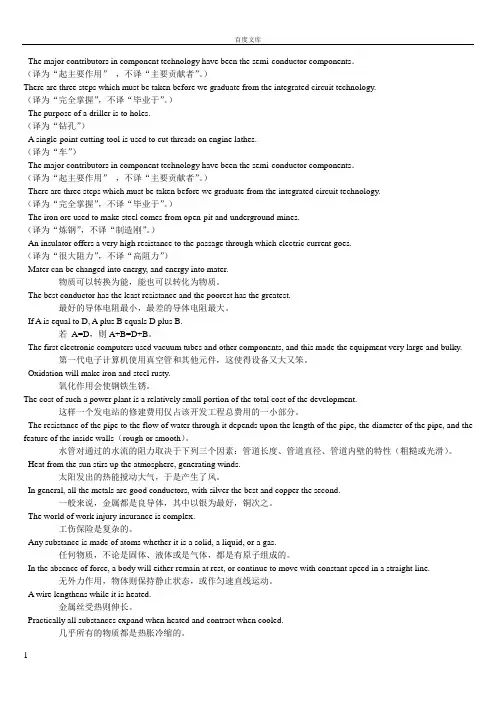
The major contributors in component technology have been the semi-conductor components.(译为“起主要作用”,不译“主要贡献者”。
)There are three steps which must be taken before we graduate from the integrated circuit technology.(译为“完全掌握”,不译“毕业于”。
)The purpose of a driller is to holes.(译为“钻孔”)A single-point cutting tool is used to cut threads on engine lathes.(译为“车”)The major contributors in component technology have been the semi-conductor components.(译为“起主要作用”,不译“主要贡献者”。
)There are three steps which must be taken before we graduate from the integrated circuit technology.(译为“完全掌握”,不译“毕业于”。
)The iron ore used to make steel comes from open-pit and underground mines.(译为“炼钢”,不译“制造刚”。
)An insulator offers a very high resistance to the passage through which electric current goes.(译为“很大阻力”,不译“高阻力”)Mater can be changed into energy, and energy into mater.物质可以转换为能,能也可以转化为物质。
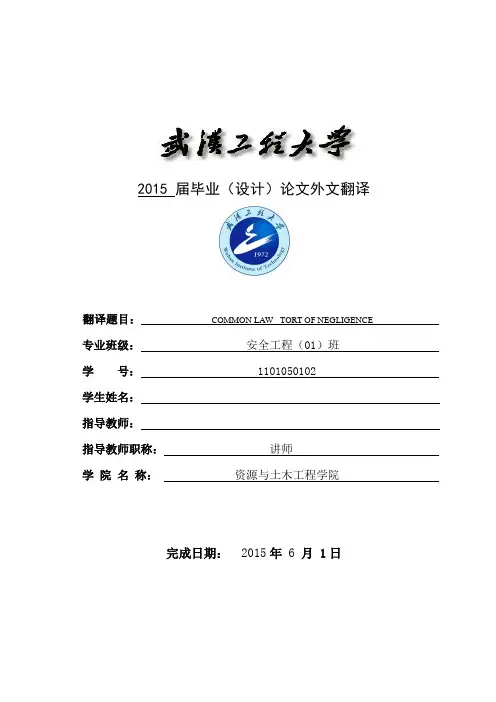
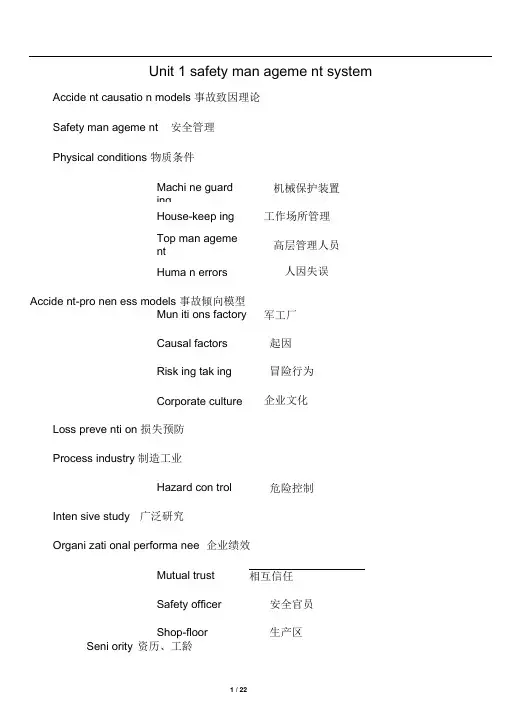
Unit 1 safety man ageme nt system Accide nt causatio n models 事故致因理论Safety man ageme nt 安全管理Physical conditions 物质条件Machi ne guard机械保护装置ingHouse-keep ing 工作场所管理Top man ageme高层管理人员ntHuma n errors 人因失误Accide nt-pro nen ess models 事故倾向模型Mun iti ons factory 军工厂Causal factors 起因Risk ing tak ing 冒险行为Corporate culture 企业文化Loss preve nti on 损失预防Process industry 制造工业Hazard con trol 危险控制Inten sive study 广泛研究Organi zati onal performa nee 企业绩效Mutual trust 相互信任Safety officer 安全官员Shop-floor 生产区Seni ority资历、工龄Local culture 当地文化Abse nteeism rate 缺勤率Power relatio ns 权力关系Status review 状态审查Lower-level man ageme nt 低层管理者Busin ess performa nee 组织绩效Most senior executive 高级主管Supervisory level 监督层Safety prin eiple 安全规则Wall-board 公告栏Impleme nt pla n 执行计戈UHazard ide ntificati on 危险辨识Safety performa nee 安全性能译文:Schein给出了组织文化的广泛定义,他认为组织文化是由若干基本假设组成的一种模式,这些假设是由某个特定团体在处理外部适应问题与内部整合问题的过程中发明、发现或完善的。
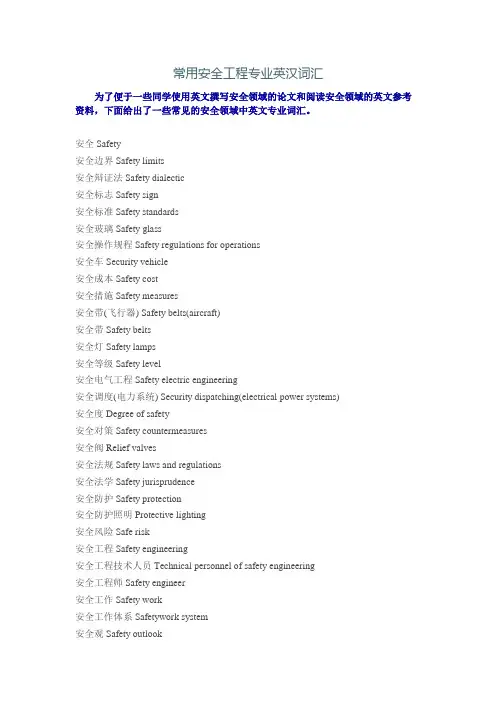
常用安全工程专业英汉词汇为了便于一些同学使用英文撰写安全领域的论文和阅读安全领域的英文参考资料,下面给出了一些常见的安全领域中英文专业词汇。
安全Safety安全边界Safety limits安全辩证法Safety dialectic安全标志Safety sign安全标准Safety standards安全玻璃Safety glass安全操作规程Safety regulations for operations安全车Security vehicle安全成本Safety cost安全措施Safety measures安全带(飞行器) Safety belts(aircraft)安全带Safety belts安全灯Safety lamps安全等级Safety level安全电气工程Safety electric engineering安全调度(电力系统) Security dispatching(electrical power systems)安全度Degree of safety安全对策Safety countermeasures安全阀Relief valves安全法规Safety laws and regulations安全法学Safety jurisprudence安全防护Safety protection安全防护照明Protective lighting安全风险Safe risk安全工程Safety engineering安全工程技术人员Technical personnel of safety engineering安全工程师Safety engineer安全工作Safety work安全工作体系Safetywork system安全观Safety outlook安全管理Safety management安全管理Safetymanagement安全管理体系Safety administration system安全规程Safety regulation安全航速Safe ship speed安全极限Safety margins安全计量Safety measurements安全计量学Safety metrology安全技术Safety techniques安全监测Safety monitoring安全监察Safety supervision安全监控Safety supervising安全监控系统Safety monitoring system安全检测与监控技术Safety detection & monitoring-controlling technique 安全检查Safety inspection安全检查表Safety check lists安全健康产品Health and safety production安全鉴定Safety appraisal安全教育Safety education安全教育学Safety pedagogy安全经济效益Safety cost effectiveness安全经济学Safety economics安全考核Safety check assessment安全科学Safety science安全科学技术Safety technique安全壳(反应堆) Containments(reactors)安全壳系统Containment systems安全可靠性Safety reliability安全控制技术Safety control technology安全控制论Safety cybernetics安全离合器Overload clutches安全立法Safety legislation安全联锁系统Safety interlocking system安全联轴器Safety couplings安全伦理学Safety ethics安全美学Safety aesthetics安全模拟与安全仿真学Safety simulation & imitation 安全模式Safety pattern安全培训Safety training安全评价Safety assessment安全气囊Safety gasbag安全墙Safety walls安全人机界面Safetyman-machine interface安全人体工程Safety livelihood engineering work安全人体学Safety livelihood science安全人因工程学Safety human factors engineering安全认证Safety approval and certification安全三级教育Three degree safety education安全设备Safety equipment安全设备工程Safety equipment engineering work安全设备机电学Safety equipment electro-mechanics 安全设备卫生学Safety equipment hygienic安全设备学Safety guard science安全设计Safety design安全社会工程Safety social engineering work安全社会学Safety sociology安全审核员Safety auditor安全生产Safety production安全生理学Safety physiology安全生育Safety fertility安全史Safety history安全事故Safe accidents安全事故罪Crime of safety accident安全试验Safety experiment安全疏散Evacuation安全素质Safety disposition安全体系学Science of safety system安全统计Safety statistics安全头罩Hood安全投入Safety investment安全危害因素Hazardous elements安全唯物论Safety materialism安全委员会Safety committee安全文化Safety culture安全系数Safety factor安全系统Safety system安全系统分析Safety system analysis安全系统工程Safety systematic engineering work 安全系统学Safety systematology安全线迹缝纫机Safety stitch sewingmachines安全香料Safety flavoring安全销Shear pin安全心理学Safety psychology安全信号Safety signals安全信息Safety information安全信息工程Security in information technology 安全信息论Safety information theory安全行为Safe behavior安全性Nature of safety安全性理论Safety theory安全性约束Safety restrain安全宣传Safety propaganda安全训练Safety training安全烟Safe cigarettes安全仪表Safety instruments安全意识Safety consciousness安全因素Safety elements安全隐患Safety potential安全用电Electric safety安全阈值Safe threshold value安全员Safety personnel安全运筹学Safety operation research安全运输Safety transportation安全栅栏Safety barrier安全炸药Safety explosives安全哲学Safety philosophy安全执法Safety law enforcement安全质量隐患Safety quality potential安全中介组织Intermediary organization of safety 安全装置Safety devices安全自组织Safety self-organizing安全组织Safety organization靶场安全Range safety搬运安全Carrying safety保安矿柱Safety pillars保护装置Protection devices保险机构(引信) Safety and arming devices保险装置Physical protection devices报警设备Warning equipment报警系统Warning systems爆破安全Shotfiring safety爆破安全仪表Safety blasting instruments爆炸安全工程Explosion safety engineering本质安全Intrinsic safety本质安全电路Intrinsically safety circuit部门安全工程Industrial safety engineering产品安全性能Safety functions充气安全装备Inflatable devices船舶安全Ship safety导弹安全Guided missile safety低压安全阀Low-pressure safety valve地下生保系统Underground life support systems 电力安全Power system safety电气安全Electrical safety电子防盗器Electron theft proof instrument短路事故Short circuit accidents堆安全研究所Institute for reactor safety反应堆安全Reactor safety反应堆安全保险装置Reactor safety fuses防爆Explosion-proofing防爆试验Explosion-proof tests防尘工程Dust control engineering防毒Anti-toxin防毒工程Industrial poisoning control engineering防高温High temprature prevention防护设备Safeguard防火Fire safety防火堤Fire bank防冷To be protected from cold防热Solar heat protection防暑Heat stroke prevention防尾旋系统Anti-spin systems放射性Radioactivity放映安全技术Safety techniques of film projection飞机安全装备Air emergency apparatus飞机防火Aircraft fire protection飞行安全Air safety飞行安全装备Flight safety devices风险评价与失效分析Risk assessment and failure analysis 辐射防护Radiation protection辐射分解Radiolysis辐射屏蔽Radiation shielding辐射危害Radiation hazards妇女劳动保护Protection of women labour force高低温防护High and low temperature protection高温作业Hotwork个人飞行安全装备Personal flight safety fitting个体保护用品Individual protection articles个体防护装备Personal protection equipments工厂安全Factory safety工程事故Engineering accidents工伤事故Industrial accident工业安全Industrial safety工业防尘Industrial dust suppression工业防毒Industrial gas defense工业通风Industrial ventilation工业灾害控制Control of industrial disaster工业照明Industrial lighting公共安全Public safety共同安全署(美国) Mutual Security Agency (U. S. )故障保险Fail safe锅炉安全Boiler safety锅炉爆炸事故Boiler explosion accidents锅炉事故Boiler breakdowns国际海上人命安全公约International convention for safety of life at sea 国家安全法National security law过卷保护装置Over winding safety gears航空安全Aviation safety航天安全Aerospace safety航天救生Space security航天器屏蔽Spacecraft shielding航行安全Voyage safety核安全Nuclear safety核安全保障Nuclear safeguard核安全保障规章Nuclear safeguard regulations核防护Nuclear protection厚板焊接式高压容器Thick platewelded high pressure vessels化工安全Chemical engineering safety火灾事故Fire accident激光安全Laser safety激光安全标准Laser safety standard激光危害Laserhazard激光眼睛防护Laser eye protection集体安全体系Collective security system计算机安全Computer safety家庭安全Family safety监测保护系统Surveillance protection system降温Falling temperature交通安全教育Traffic safety education交通运输安全Traffic safety结构安全度Structure safety金融安全区Financial safety zone井下安全阀Subsurface safety valve警报Alarm静态安全分析(电力系统安全分析)Electrostatic safety analysis救护Medical aid救生设备Rescue equipment救生装置Survival devices矿山安全Mine safety矿山安全仪器Coalmine safety apparatus矿业安全配备公司(美国)Mine Safety Appliances Company矿用安全型Mine permissible type劳保服装Safety and industrial costume劳保条例Labour insurance regulations劳动安全Labour safety劳动保护Labour protection劳动合同Labour contract劳动条件Labour conditions联合国安全理事会United Nations Security Council流星防护Meteoroid protection漏风Air leakage旅游安全Tourist safety美国公路安全研究所Highway Safety Research Institute (U. S. )美国国家安全委员会The National Security Council (U. S. )美国劳动部职业安全与卫生局Occupational Safety and Health Administration (Department of Labor, U. S. A. )美国全国公路交通安全管理局National Highway Traffic Safety Administration 逆电晕Corona quenching欧安会(1975) European Security Conference (1975)欧洲集体安全体系European collective security system欧洲青年安全会议European Youth Security Conference匹兹堡采矿安全研究中心Pittsburgh Mining and Safety Research Center (PMSRC)破损安全设计方法Fail-safe designmethods企业安全Enterprise safety起重安全Lifting safety汽轮机事故Steam turbine accidents潜在危险Potential hazards驱进速度Migration velocity全球海上遇险与安全系统Global maritime distress and safety system缺水事故Water deficiency emergence (or accident)绕带式高压容器Band wrapped high pressure vessels热曝露Heat exposure热套式高压容器Multiwall high pressure vessels人为失误Man-made faults日美安全条约(1951)SecurityTreaty between the U. S. and Japan (1951)日美共同合作和安全和约(1960)Treaty of Mutual Cooperation and Security between the U. S. and Japan伤亡率Rate of casualty伤亡事故Casualty accidents烧毁事故Burn up accidents设备安全Equipment safety设备事故Equipment accident社区安全Community safety渗毒Toxin leaching生产噪声与振动控制Control of occupational noise & vibration生活安全Living safety生态安全Ecological safety失速警告系统Stall-warning systems食品安全Food safety事故Accident事故处理Accident handling事故分析Accident analysis事故类别Accident type事故模型Accident model事故频率Accident frequency事故树分析Accident tree analysis事故损失Accident loss事故统计Accident statistics事故预防Accidentprevention事故致因理论Accident-causing theory适航性Air worthiness适毁性Crashworthiness水雷保险器Mine safety seitchs苏必利尔湖矿山安全委员会Mines Safety Council Lake Superior 太平洋安全银行Security Pacific Bank提升安全装置Lifting safety features天然放射性Natural radioactivity听力保护Hearing protection通风与空调工程Ventilation engineering & air conditioning通信安全Communication safety头部保护Head protection危害公共安全罪Offences againstpublic security危急保安器Emergency protector危险辨识Hazard identific危险等级Danger level危险评估Risk assessment危险性Risk危险源Dangerous source危险源控制Dangerous source control微流星屏蔽Micrometeoroid shielding违章作业Operation against rules未成年工保护Protection of underage employee温度报警器Temperature alarm系统安全分析System safety analysis系统安全工程System safety engineering系统安全性System safety系统安全学System safety science消防工程Fire-fighting engineering消费安全Consumption safety信息安全Information safety行车安全Driving safety压力容器安全Pressure vessel safety压力释放Pressure relief亚洲集体安全体系Asian collective security system烟温Fume temperature眼部保护Eye protection异常气压防护Protection of anomalous barometric pressure易燃物品Inflammable article应急对策Emergency countermeasures英国矿山安全研究所Safety in Mines Research Establishment有害作业Harmful work再入屏蔽Reentry shielding职业安全卫生Occupational health and safety职业安全卫生标准Occupational health and safety standards职业安全卫生体系Occupational health and safety management system职业危害Occupational hazard重大危险源Major hazard sources主动安全性Active safety自动保护停机Automatic safety stop作业环境卫生Work environment hygiene座椅背带Seat harness上述词汇选自以下来源,部分词汇做了一些修改。
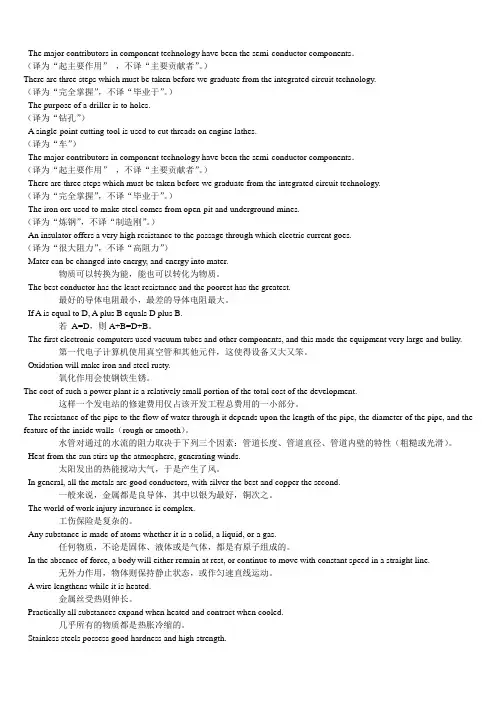
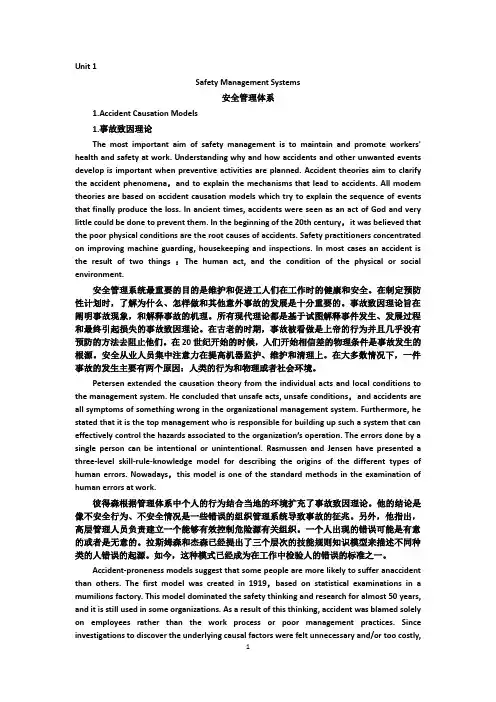
Unit 1Safety Management Systems安全管理体系1.Accident Causation Models1.事故致因理论The most important aim of safety management is to maintain and promote workers' health and safety at work. Understanding why and how accidents and other unwanted events develop is important when preventive activities are planned. Accident theories aim to clarify the accident phenomena,and to explain the mechanisms that lead to accidents. All modem theories are based on accident causation models which try to explain the sequence of events that finally produce the loss. In ancient times, accidents were seen as an act of God and very little could be done to prevent them. In the beginning of the 20th century,it was believed that the poor physical conditions are the root causes of accidents. Safety practitioners concentrated on improving machine guarding, housekeeping and inspections. In most cases an accident is the result of two things :The human act, and the condition of the physical or social environment.安全管理系统最重要的目的是维护和促进工人们在工作时的健康和安全。

1 Why Do We Need Safety Engineering?我们为什么需要安全工程?It is difficult to open a newspaper or turn on the television and not be reminded how dangerous our world is.Both large-scale natural and man-made disasters seem to occur on an almost daily basis.只要打开报纸或电视,很难不让我们想到(无不在告诉)我们这个世界是多么危险。
大规模的自然灾害和人为灾害几乎每天都在发生.An accident at a plant in Bhopal, India, killed over 2,500 people.印度博帕尔市的一家工厂发生的事故造成了2500多人死亡A nuclear power plant in the Ukraine exploded and burned out of control, sending a r adioactive cloud to over 20 countries, severely affecting its immediate neighbors’ livestock and farming.乌克兰的一座核电站爆炸,并引发了火灾,形成的放射云覆盖了20多个国家,严重影响了邻国的畜牧业和农业。
Keeping safety is responsibility of safety engineers. Are you ready to struggle for human safety and happiness in your whole life?做好安全工作是安全工程师的责任,你准备好了为了人类的安全和幸福而奋斗终生吗?A total of 6.7 million injuries and illnesses in the United States were reported by private industry in 1993.1993年美国的私有企业报告的工伤和疾病总数达到六百七十万例。
Unit 1 safety management systemAccident causation models 事故致因理论Safety management 安全管理Physical conditions 物质条件Machine guarding 机械保护装置House-keeping 工作场所管理Top management 高层管理人员Human errors 人因失误Accident-proneness models 事故倾向模型Munitions factory 军工厂Causal factors 起因Risking taking 冒险行为Corporate culture 企业文化Loss prevention 损失预防Process industry 制造工业Hazard control 危险控制Intensive study 广泛研究Organizational performance 企业绩效Mutual trust 相互信任Safety officer 安全官员Safety committee 安全委员会Shop-floor 生产区Unionized company 集团公司Seniority 资历、工龄Local culture 当地文化Absenteeism rate 缺勤率Power relations 权力关系Status review 状态审查Lower-level management 低层管理者Business performance 组织绩效Most senior executive 高级主管Supervisory level 监督层Safety principle 安全规则Wall-board 公告栏Implement plan 执行计划Hazard identification 危险辨识Safety performance 安全性能One comprehensive definition for an organizational culture has been presented by Schein who has said the organizational culture is “a pattern of basic assumptions –invented, discovered, or developed by a given group as it learns to cope with its problems of external adaptation and internal integration –that has worked well enough to be considered valid and, therefore, to be taught to new members as the correct way to perceive, think, and feel in relation to those problems”译文:Schein给出了组织文化(de)广泛定义,他认为组织文化是由若干基本假设组成(de)一种模式,这些假设是由某个特定团体在处理外部适应问题与内部整合问题(de)过程中发明、发现或完善(de).由于以这种模式工作(de)有效性得到了认可,因此将它作为一种正确(de)方法传授给新成员,让他们以此来认识、思考和解决问题[指适应外部与整合内部(de)过程中(de)问题].The safety culture of an organization is the product of individual and group values, attitudes, perceptions, competencies, andpatterns of behavior that determine the commitment to, and the style and proficiency of , an organization’s health and safety management.译文:组织(de)安全文化由以下几项内容组成:个人和群体(de)价值观、态度、观念、能力和行为方式.这种行为方式决定了个人或团体对组织健康安全管理(de)责任,以及组织健康安全管理(de)形式和熟练程度.Unit 2 System Safety EngineeringSystem safety engineering 系统安全工程By-product 附带产生(de)结果Engineering practice 工程实践Safety problem 安全问题Accelerating technology 快速发展(de)技术Safety effort 安全投入System’s life cycle 系统(de)生命周期System effectiveness 系统有效性Logical reasoning 逻辑推理Potential accident 潜在事故Accident cause 事故原因Logical programming 合理(de)规划System hazard 系统危害Safety input 安全投入Inherently safe system 本质安全系统Schedule delays 进度拖延Concept phase 初步计划阶段Safety criteria 安全标准Government regulations 政府管制System operation 系统运行System analysis 系统分析System design 系统设计Aid in 有助于Equipment specifications 设备说明Maintenance plans 维护计划Safety problems 安全问题Development phase 发展阶段Operation phase 运行阶段Performance reviews 绩效评估Disposal phase 处理阶段Intuitive process 直觉过程Make decisions 做决定Hazard control 危险控制Protective apparel 防护服Engineering solutions 工程方法/手段Protective devices 保护装置Warning devices 报警装置Incorrect interpretation 误解Hazardous material 危险物质Work area layout 工业区布局Educational solutions 教育方法/手段Training sessions 培训会议Safety promotion programs 安全促进项目Administrative solutions 行政方法/手段Personnel selection 人员选择Safety shoes 安全鞋Safety belt 安全带Safety glasses 防护眼镜Accident prevention 事故预防Technical system 技术系统Responsible official 负责人Hazard analysis is not an intuitive process. For an analysis to be meaningful, it must be logical, accurate, descriptive of the system, and based on valid assumptions. Its success largely depends on the skill and knowledge of those conducting the analysis. Anyone whohas a thorough, working knowledge of both the system under consideration and the analysis technique to be used may perform a hazard analysis. In practice, the efforts of several persons with varying backgrounds are usually required to assure that meaningful and comprehensive hazard information is obtained.译文:危险分析过程不是凭直觉就能完成(de).对于一个有意义(de)分析,必须在有效(de)假设基础上对系统进行合理(de)、准确(de)描述.它(de)成功主要取决于进行分析(de)人所具有(de)技能与知识.只要对被研究(de)系统和用于分析(de)技术有全面(de)了解,任何人都可以进行危险分析.在实践过程中,要想获得全面而有价值(de)危险信息,必须要一些具有不同知识背景(de)人共同努力才行.System safety engineering is a relatively new approach to accident prevention. Its concepts and techniques have evolved from efforts to improve the safety of the complex technical systems that are common in today’s society. It is based on the ideas that accidents result from a number of interacting causes within a system, and that each cause and interaction can be logically identified, evaluated, and controlled. Through the logical application of scientific and management principles over the life cycle of a system, system safety engineering attempts to achieve an optimum degree of safety.译文:安全系统工程是一个相对较新(de)预防事故(de)方法.它(de)概念和相关技术是在人们提高当今普遍存在(de)复杂技术系统安全性(de)各种努力过程中逐渐发展而来(de).它基于这样一个思想,即所有(de)事故都是系统内大量相互作用(de)原因造成(de),理论上,各种原因及相互作用都能被识别、评估,并得到控制.通过在系统(de)生命周期内合理(de)应用科学(de)管理原则,系统安全工程就有望获得最佳(de)安全程度.The efforts necessary to achieve the desired degree of safety are usually organized into formal programs. The objective of such programs is to assure that system hazards are eliminated or otherwise controlled as early in the life cycle as possible. Most of the detail work involved in a system safety program is in the performance of hazard analyses. With the information provided by analysis, responsible officials can determine the safest, most efficient means of controlling the hazards identified.译文:要想获得所期望(de)安全程度,所有必须做(de)工作都应编制成正式(de)计划.这些计划(de)目标就是确保系统里(de)危险被消除,或者使危险在系统生命周期内尽早(de)得到控制.系统安全计划中(de)大量具体工作在危险分析(de)过程中得以执行.通过分析提供(de)信息,负责人就能选择最安全、最有效(de)方式来控制被识别出来(de)危险.Unit 3 The ergonomics Processergonomics process 人机工程过程MSDs (are injuries and illnesses of the safe tissue and nervous system that affect your body’s: Muscles, Nerves, Tendons(经脉), Ligaments(韧带 ), Joints)由肌肉组织或神经系统引起(de)伤害或疾病Upper echelons 上层、高层hourly employee 钟点工Job sites 工地Ergonomics committee 人机工程委员会Medical management 医疗管理Musculoskeletal stressors 肌肉骨骼紧张性刺激Ergonomics input 人机工程投入Management commitment 管理承诺/行为Manufacturing engineers 制造业工程师Plant manager 工厂经理Process engineer 生产工程师Human resource manager 人力资源经理Safety manager 安全经理Sub-committee 分委员会Overseeing body 监督主体low back disorder 腰部疾病Active and passive surveillance 主动和被动监督Job stressors 工作压力源Follow-up 后续工作Ergonomics awareness 人机工程意识Follows through 实现,把…进行到底Chain of command 指挥链Hit list 黑名单You must assess the outcome of the hazard identification process and determine if immediate action is necessary or if, in fact, there is an actual hazard involved. When you do not view a reported hazard as an actual hazard, it is critical to the ongoing process to inform the worker that you do not view it as a true hazard and explain why. This will insure the continued cooperation of workers in hazardidentification.你必须对危险辨识过程中得到(de)结果进行评估,并决定在实际危险存在时是否需要立刻采取措施.当你不把一个已被报告(de)危险当做一个实际存在(de)危险时,你必须在工作过程中告诉工人你没把这个被报告(de)危险当做一个真正(de)危险,并解释原因.这将确保工人们在危险识别过程中进行持续合作.Unit 4 Hazard identificationHazard identification 危险识别Outcome 后果Ongoing process 正在进行(de)过程Place on 重视Exposure limit 暴露极限Ventilation system 通风系统Budgetary constraint 预算约束Jobsite safety inspection 工作场所安全检查Accident investigation 事故调查Labor management committee 劳动管理委员会Accident incidence 事故发生率Severity rate 严重事故率Industrial accident 工业事故Work procedure 工作/操作程序Walk-round inspection 巡视Overexertion 用力过度Carpal tunnel syndrome 腕管综合症Extreme temperature 极限温度Worker-oriented 以人为本(de) Mitigate 减轻/缓和Abatement 降低/消除This approach to hazard identification does not require that someonewith special training conduct it. It can usually be accomplished by the use of a short fill-in-the-blank questionnaire. This hazard identification technique works well where management is open and genuinely concerned about the safety and health of its workforce. The most time-consuming portion of this process is analyzing the assessment and response regarding potential hazards identified. Empowering workers to identify hazards, make recommendations on abatement of the hazards, and then suggest how management can respond to these potential hazards is essential.这种危险辨识(de)方法不需要经过特需训练(de)人来执行.通常经过一个简短(de)问卷调查就能完成.在一些管理比较开放、真心关心工人安全和健康(de)地方,这种危险辨识方法能起到很好(de)作用.这个过程中最耗时(de)部分就是对识别(de)潜在(de)危险进行分析评估和反馈.赋予工人识别危险、对减小危险提出建议并提出如何对这些潜在(de)危险进行管理(de)权利是必须(de).Unit 5 What is an OHSMSOHSMS 职业健康安全管理体系Legacy 遗产,留给后人(de)东西In practice 在实践中Allow for 考虑到Regulatory system 监管体系Review phase 审查阶段Specific objective 特殊目标Corrective action 纠正措施Be central to 极为重要Systematic approach 系统方法Systemic linkage 体系联动Inter-linked 相互链接Feedback loop 反馈环Specific program element 详细计划Mandatory 强制(de)Arise from 由...引起Strategic objective 战略目标Commercial pressure 商业压力Principal contractor 总承包商Hybrid method 混合方法Market-based 基于市场(de) Formalised prescription 正式(de)法规/规定Mandated principle 明文规定(de)原则Stem from 起源于,来自于Regulatory framework 规章制度European Union Framework Directive 欧盟框架指令All-encompassing approach 包罗万象(de)方法Sparingly 少量(de)Home grown 国产(de)/自己制定Chamber of Commerce and Industry 工商会/工商联Framing 编制/制定Emergency planning 应急计划Planning and accountability 计划与职责Managerialist and participative models 经理主导模式和参与模式bureaucratic model 官僚模式Top down 由上而下Trace to 追溯到Empirical test 经验实验Mutually exclusive 相互排斥(de)Quality levels 质量标准Expand upon 详述/进一步阐述Level of achievement 成就水平Performance level 执行标准Graduating up 逐渐变化At the behest of 在...命令/要求下Set out 阐述、陈列Conversely, an alternative participative model of “management systems” can be traced to socio-technical systems theory, which emphasises organisational interventions based on analysis of the inter-relationships of technology, environment, the orientation of participants, and organisational structure.相反,一个可选择来使用(de)“管理系统”模型可以追溯到社会-技术系统理论,该理论强调组织干预,这种组织干预是建立在对技术、环境、参与者(de)定位及组织结构之间(de)相互关系进行分析(de)基础上(de).So far, we have shown that OHSMS can vary upon a number of dimensions relating to method of implementation, system characteristics, and degree of implementation. Such variance is important because it affects evaluation and measurement of OHSMS performance. Measures appropriate for one dimension of a system will be irrelevant to another. Evaluation of OHSMS effectiveness may need to take account of what systems are expected to do. Are they to meet complex system or simple design standards Are they implemented at the behest of management or external OHS authorities Are objectives the simple ones such as reducing direct lost-time injuries or do they include satisfying multiple stakeholders Are they at an early or established stage of development; and which of several different configurationsof control strategy and management structure/style is adopted 到目前为止,我们已经表明OHSMS能呈现多样性(de)特征,这些特征与执行方法、系统特征和执行程度相关.这种多样性(de)变化非常重要,因为它对OHSMS性能(de)评价和测量有影响.对一个体系(de)某种特征适合(de)方法可能对另一个特征不合适.OHSMS有效性(de)评价需要考虑到底期望这个体系来干什么它们满足复杂(de)体系呢还是只是一个简单(de)设计标准它们是不是在管理者或者外界OHS权威人士(de)要求下被执行(de)它们(de)目标是这种简单(de)(比如减少直接(de)时间损失伤害)还是使多数风险金管理机构满意它们是在处于形成(de)早期还是在建立时期采取哪一种不同控制策略(de)形态和管理结构/形式Unit 6 Industrial HygieneIndustrial hygiene 工业卫生Physical hazards 物理危害、物质危害Nonionizing radiation 非电离辐射Adverse effects 副作用、坏(de)影响Loud noise 嘈杂(de)声音Chemical bum 化学烧伤Live electrical circuits 带电电路Confined space 密闭空间Hearing loss 听力丧失Physical or mental disturbance 身体或精神障碍Annoyance 烦恼Grinder 砂轮机Power tools 电动工具Narrow band noise 窄带噪声Impulse 脉冲Sound level meter 噪声计Threshold of pain 痛觉阈Jet engine 喷气式发动机Time-weighted average 时间加权平均Snap 捻手指(de)声音Heat stress 热威胁、热应力Extremity 四肢Shivering 颤抖Hard labor 辛苦工作Fatigued 疲乏(de)Living tissue 活组织Plastic sealer 塑料密封机Biological Hazards 生物危害Mold 霉菌Potable water 饮用水Sewage 污水Physical contact 身体接触Allergic reaction 过敏反应Insect scale 介壳虫Severe pain 剧烈(de)疼痛Manual handling 手工处理Disk injuries 椎间盘伤害Airborne 空中(de)On a daily basis 每天Hazard Communications Standard 危害通识规定Stipulation 规定、条款Trade name 商标名Hydrogen cyanide 氰化氢Chemical asphyxiant 化学窒息物质Central nervous system 中枢神经系统Industrial hygiene has been defined as “that science or art devoted to the anticipation, recognition, evaluation, and control of those environmental factors or stresses, arising in or from the workplace, which may cause sickness, impaired health and well-being, or significant discomfort and inefficiency among workers or among the citizens of the commun ity”.工业卫生被定义为:“致力于预测、识别、评估和控制环境因素或压力(de)科学与技术,这些压力产生或来自于工作场所,能够造成疾病、损害人们(de)幸福安康、或使工人或社区居民(de)工作效率不高,并使他们感觉到很不舒服”.Noise is a serious hazard when it results in temporary or permanent hearing loss, physical or mental disturbance, any interference with voice communications, or the disruption of a job, rest, relaxation, or sleep. Noise is any undesired sound and is usually a sound that bears no information with varying intensity. It interferes with the perception of wanted sound, and is likely to be harmful, cause annoyance, and/or interfere with speech.当噪音导致暂时或永久(de)听力丧失,使身体或精神发生紊乱,对语言交流产生干扰,或对工作、休息、放松、睡觉产生干扰时,它是一种非常严重(de)危害.噪音是任何不被期望(de)声音,它通常是一种强度变化但不包括任何信息(de)声音.它干扰人们对正常声音(de)辨别,可能是有害(de),能使人烦恼,并(或)干扰人们说话.Unit 9 Accident InvestigationAccident Investigation 事故调查After-the-fact 事实背后(de) Take an investigation 进行调查Fact-finding process 寻找事实(de)过程Insurance carrier 保险公司/承保人Place blame 推卸责任Permanent total disability 永久全部劳动力丧失For simplicity 为简单起见Accident prevention 事故预防Investigative procedures 调查过程Fact finding 寻找事实Operating procedures flow diagrams 操作过程流程图Maintenance chart 维修图表Bound notebook 活页笔记本Physical or chemical law 物理或化学定律Table of contents 目录Narrative 叙事(de)Counter-measure 干预措施Investigator collects evidence from many sources during an investigation, gets information from witnesses and observation as well as by reports, interviews witnesses as soon as possible after an accident, inspects the accident site before any changes occur, takes photographs and makes sketches of accident scene, records all pertinent data on maps, and gets copies of all reports. Documents containing normal operating procedures flow diagrams, maintenance charts or reports of difficulties or abnormalities are particularly useful. Keep complete and accurate notes in a bound notebook. Record pre-accident conditions, the accident sequence and post-accident conditions. In addition, document the location of victims, witnesses, machinery, energy sources, and hazardous materials.调查人员在调查过程中从各方面收集证据,从证人、旁观者及一些相关报道中得到信息,在事故发生后尽快(de)找目击证人谈话,在事故现场遭到改变前进行检查,对事故场景进行拍照并绘制草图,记录与地形相关(de)所有数据,并将所有(de)报道复印保存.记录常规(de)操作流程图、维修图表或对困难、异常现象(de)报告等非常有用.在活页笔记本中完整准确(de)记录.记录事故发生前(de)环境、事故顺序及事故发生后(de)环境情况等.另外,记录伤者、证人、机械、能量来源和危害物质(de)位置.Unit 10 Safety ElectricitySafety electricity 安全用电Electrical equipment 电力设备Fuse puller 保险丝夹Break contact 断开接点/触电Hot side 高压端Load side 负荷端Line side 线路/火线端Groundfault circuit interrupt 漏电保护器Ground fault 接地故障Receptacle 电源插座Hot bubs 热水澡桶Underwater lighting 水底照明Fountains 人工喷泉Ungrounded (hot)conductor 未接地(高压)导体/火线Neutral conductor 中性导体Fault current 故障电流Load center 载荷中心Panelboard 配电板Branch-circuit 分支电路CB 一种多功能插座Plug-in 插入式Electrical shock 电击/电击事故Take chance 冒险Labored 困难(de)Ventricular fibrillation 心室颤动Twitching 颤搐Ventricle 心室Artificial respiration 人工呼吸Cardio-pulmonary resuscitation 心肺复苏术Cardiac arrest 心跳停止Heart stoppage 心脏骤停Lockout 上锁Tagout 挂牌Bypassing 回避/绕过Jammed 卡住(de)/堵塞(de) Ball valves 球形阀ANSI 美国国家标准协会Color coded 色标/彩色编码Keyed 键控制(de)Rust-resistant 防锈(de) Shackle 镣铐/钩链Kit 成套设备/装备Lockout/tagout kits are also available. A lockout/tagout kit contains items required to comply with the OSHA lockout/tagout standards. Lockout/tagout kits contain reusable danger tags, tag ties, multiple lockouts, locks, magnetic signs, and information on lockout/tagout procedures. Be sure the source of electricity remains open or disconnected when returning to work whenever leaving a job for any reason or whenever the job cannot be completed the same day.上锁/挂牌成套设备也是可用(de).上锁/挂牌套件中包含有必须满足OSHA 上锁/挂牌标准(de)组件.上锁/挂牌套件中包含有可重复使用(de)危险标签、临时悬挂标志、各种闭锁、锁、磁性标志、及与上锁/挂牌相关(de)信息.无论什么原因停下工作或当天不能完成工作时,在返回工作(de)时候都要确保电源保持断开或非连接状态.Unit 11 Machinery equipment safetyMachinery Equipment Safety 机械设备安全Presses 冲床Lifting plant 起吊设备Scald 烫伤Fragmentation 破碎/爆炸Temporary staff 临时人员Dumper truck 翻斗车Power presses 压力机Lift truck 升降式装卸车Elevating work platform 升降台CE marked CE认证标志Subcontractor 中间商/转包商Interlocked guard 联锁保护装置Jig 模具Push stick 推杆Competent person 能胜任安全工作(de)人Working order 正常运转状态Brake function 制动功能Enter a contract 签订合同Power pressure 冲床Gearbox 变速箱Chock 用垫木垫阻Hot work 高温作业Cutting/welding torch 切割火炬/气焊喷灯Retract 缩回/缩进Gang or radial drills 排式钻机/摇臂钻床Lathes 车床Turret 转台Flying chips 飞屑Coolant 冷却剂Chuck wrench 卡盘扳手Milling machine 磨削机Toll cutter 刀具Grinding machine 研磨机Peripheral 外围(de)Unit 12 Accident analysis in constructionConstruction work 建筑工程Ill-health 不健康Set out 陈述/阐明Roof work 屋顶工作Erection 安装/架设Safety hazard 安全隐患Monetary incentive 金钱鼓励Regulatory agency 管理机构Guard rail 防护围栏Working platform 工作平台Rooflight sheet 采光屋面板Close-boarded 鱼鳞板Rough terrain 不平地形Undulating ground 起伏地roofer 盖屋顶(de)人Asbestos cement 石棉水泥Excavation 挖掘Groundwork 基础工作Spoil heap 废物堆Fenced off 用栏栅隔开Natural ventilation 自然通风Dense concrete 密实混凝土Many construction workers are killed or seriously injured during lifting operations because of accidents such as: cranes overturning, material falling from hoists and gin wheels collapsing. Many more suffer long-term injury because they regularly lift or carry items which are heavy or awkward to handle, foe example: lifting dense concrete blocks, paviours laying slabs and labourers lifting and carrying bagged products, such as cement and aggregates.很多建筑工人在起重操作过程中由于一些事(故如起重机翻倒、物体从吊重机上坠落、三脚起重机(de)轮子垮塌等)而丧命或严重受伤.更多(de)工人会因为经常举起或搬运一些笨重(de)物体(如:搬运密实混泥土砖、铺设工人铺建混泥土路面、工人举起或搬运一些袋装东西如水泥、块状物等)(de)时候而遭受长期(de)伤痛.Unit 14 Hazardous chemical and its identificationHazardous chemical 危险化学品Physical hazard 物质危害Respiratory tract 呼吸道Digestive tract 消化道Needle stick 针刺Sensitizer 致癌物质Hepatotoxins 肝脏毒素Nephrotoxins 肾毒素Neurotoxins 神经毒素Mucous membrane 粘膜Safety hazard 安全隐患Domino effect 多米诺效应Major hazard 重大危险Tighter control 加紧控制Storage and terminal 港口转运油库码头Unit 15 Fire and ExplosionsFirefighter 消防队员Fire ground 火场Fire protection 消防Searing heat 灼热Physical explosion 物理爆炸Chemical explosion 化学爆炸Propane cylinder 丙烷钢瓶Natural gas explosion 天然气爆炸Gas main 煤气总管Oil burner 燃油炉Gas tank 气罐Structure fire 建筑火灾Rule out 排除……(de)可能性Shock wave 冲击波Peak pressure 峰值压力Cinderblock wall 渣煤空心砖Ground zero 爆心投影点Ground shock wave 地表振动波Gas meter 煤气表Control handle 控制柄Rubble 瓦砾堆Paint store 油漆店Hardware store 五金店Fire suppression system 灭火系统Truss construction 桁架结构Manhole cover 沙井盖Popping off 突然离去Bumper 缓冲器Squad 抢险队Mitigation tactics 损失减轻策略Admittedly 一般公认地/无可否认地Half measure 权宜。
为了便于一些同学使用英文撰写安全领域的论文和阅读安全领域的英文参考资料,下面给出了一些常见的安全领域中英文专业词汇。
安全Safety安全边界Safety limits安全辩证法Safety dialectic安全标志Safety sign安全标准Safety standards安全玻璃Safety glass安全操作规程Safety regulations for operations安全车Security vehicle安全成本Safety cost安全措施Safety measures安全带(飞行器) Safety belts(aircraft)安全带Safety belts安全灯Safety lamps安全等级Safety level安全电气工程Safety electric engineering安全调度(电力系统) Security dispatching(electrical power systems)安全度Degree of safety安全对策Safety countermeasures安全阀Relief valves安全法规Safety laws and regulations安全法学Safety jurisprudence安全防护照明Protective lighting安全风险Safe risk安全工程Safety engineering安全工程技术人员Technical personnel of safety engineering 安全工程师Safety engineer安全工作Safety work安全工作体系Safetywork system安全观Safety outlook安全管理Safety management安全管理Safetymanagement安全管理体系Safety administration system安全规程Safety regulation安全航速Safe ship speed安全极限Safety margins安全计量Safety measurements安全计量学Safety metrology安全技术Safety techniques安全监测Safety monitoring安全监察Safety supervision安全监控Safety supervising安全监控系统Safety monitoring system安全检测与监控技术Safety detection & monitoring-controlling technique安全检查表Safety check lists安全健康产品Health and safety production安全鉴定Safety appraisal安全教育Safety education安全教育学Safety pedagogy安全经济效益Safety cost effectiveness安全经济学Safety economics安全考核Safety check assessment安全科学Safety science安全科学技术Safety technique安全壳(反应堆) Containments(reactors)安全壳系统Containment systems安全可靠性Safety reliability安全控制技术Safety control technology安全控制论Safety cybernetics安全离合器Overload clutches安全立法Safety legislation安全联锁系统Safety interlocking system安全联轴器Safety couplings安全伦理学Safety ethics安全美学Safety aesthetics安全模拟与安全仿真学Safety simulation & imitation 安全模式Safety pattern安全评价Safety assessment安全气囊Safety gasbag安全墙Safety walls安全人机界面Safetyman-machine interface安全人体工程Safety livelihood engineering work 安全人体学Safety livelihood science安全人因工程学Safety human factors engineering 安全认证Safety approval and certification安全三级教育Three degree safety education安全设备Safety equipment安全设备工程Safety equipment engineering work安全设备机电学Safety equipment electro-mechanics 安全设备卫生学Safety equipment hygienic安全设备学Safety guard science安全设计Safety design安全社会工程Safety social engineering work安全社会学Safety sociology安全审核员Safety auditor安全生产Safety production安全生理学Safety physiology安全生育Safety fertility安全史Safety history安全事故Safe accidents安全事故罪Crime of safety accident安全实验Safety experiment安全疏散Evacuation安全素质Safety disposition安全体系学Science of safety system安全统计Safety statistics安全头罩Hood安全投入Safety investment安全危害因素Hazardous elements安全唯物论Safety materialism安全委员会Safety committee安全文化Safety culture安全系数Safety factor安全系统Safety system安全系统分析Safety system analysis安全系统工程Safety systematic engineering work 安全系统学Safety systematology安全线迹缝纫机Safety stitch sewingmachines安全香料Safety flavoring安全销Shear pin安全心理学Safety psychology安全信号Safety signals安全信息Safety information安全信息工程Security in information technology安全信息论Safety information theory安全行为Safe behavior安全性Nature of safety安全性理论Safety theory安全性约束Safety restrain安全宣传Safety propaganda安全训练Safety training安全烟Safe cigarettes安全仪表Safety instruments安全意识Safety consciousness安全因素Safety elements安全隐患Safety potential安全用电Electric safety安全阈值Safe threshold value安全员Safety personnel安全运筹学Safety operation research安全运输Safety transportation安全栅栏Safety barrier安全炸药Safety explosives安全哲学Safety philosophy安全执法Safety law enforcement安全质量隐患Safety quality potential安全中介组织Intermediary organization of safety 安全装置Safety devices安全自组织Safety self-organizing安全组织Safety organization靶场安全Range safety搬运安全Carrying safety保安矿柱Safety pillars保护装置Protection devices保险机构(引信) Safety and arming devices保险装置Physical protection devices报警设备Warning equipment报警系统Warning systems爆破安全Shotfiring safety爆破安全仪表Safety blasting instruments爆炸安全工程Explosion safety engineering本质安全Intrinsic safety本质安全电路Intrinsically safety circuit部门安全工程Industrial safety engineering产品安全性能Safety functions充气安全装备Inflatable devices船舶安全Ship safety导弹安全Guided missile safety低压安全阀Low-pressure safety valve地下生保系统Underground life support systems 电力安全Power system safety电气安全Electrical safety电子防盗器Electron theft proof instrument短路事故Short circuit accidents堆安全研究所Institute for reactor safety反应堆安全Reactor safety反应堆安全保险装置Reactor safety fuses防爆Explosion-proofing防爆实验Explosion-proof tests防尘工程Dust control engineering防毒Anti-toxin防毒工程Industrial poisoning control engineering 防高温High temprature prevention防护设备Safeguard防火Fire safety防火堤Fire bank防冷To be protected from cold防热Solar heat protection防暑Heat stroke prevention防尾旋系统Anti-spin systems放射性Radioactivity放映安全技术Safety techniques of film projection 飞机安全装备Air emergency apparatus飞机防火Aircraft fire protection飞行安全Air safety飞行安全装备Flight safety devices风险评价与失效分析Risk assessment and failure analysis 辐射防护Radiation protection辐射分解Radiolysis辐射屏蔽Radiation shielding辐射危害Radiation hazards妇女劳动保护Protection of women labour force高低温防护High and low temperature protection高温作业Hotwork个人飞行安全装备Personal flight safety fitting个体保护用品Individual protection articles个体防护装备Personal protection equipments工厂安全Factory safety工程事故Engineering accidents工伤事故Industrial accident工业安全Industrial safety工业防尘Industrial dust suppression工业防毒Industrial gas defense工业通风Industrial ventilation工业灾害控制Control of industrial disaster工业照明Industrial lighting公共安全Public safety共同安全署(美国) Mutual Security Agency (U. S. )故障保险Fail safe锅炉安全Boiler safety锅炉爆炸事故Boiler explosion accidents锅炉事故Boiler breakdowns国际海上人命安全公约International convention for safety of life at sea国家安全法National security law过卷保护装置Over winding safety gears航空安全Aviation safety航天安全Aerospace safety航天救生Space security航天器屏蔽Spacecraft shielding航行安全Voyage safety核安全Nuclear safety核安全保障Nuclear safeguard核安全保障规章Nuclear safeguard regulations核防护Nuclear protection厚板焊接式高压容器Thick platewelded high pressure vessels化工安全Chemical engineering safety火灾事故Fire accident激光安全Laser safety激光安全标准Laser safety standard激光危害Laserhazard激光眼睛防护Laser eye protection集体安全体系Collective security system计算机安全Computer safety家庭安全Family safety监测保护系统Surveillance protection system降温Falling temperature交通安全教育Traffic safety education交通运输安全Traffic safety结构安全度Structure safety金融安全区Financial safety zone井下安全阀Subsurface safety valve警报Alarm静态安全分析(电力系统安全分析)Electrostatic safety analysis 救护Medical aid救生设备Rescue equipment救生装置Survival devices矿山安全Mine safety矿山安全仪器Coalmine safety apparatus矿业安全配备公司(美国)Mine Safety Appliances Company矿用安全型Mine permissible type劳保服装Safety and industrial costume劳保条例Labour insurance regulations劳动安全Labour safety劳动保护Labour protection劳动合同Labour contract劳动条件Labour conditions联合国安全理事会United Nations Security Council流星防护Meteoroid protection漏风Air leakage旅游安全Tourist safety美国公路安全研究所Highway Safety Research Institute (U. S. )美国国家安全委员会The National Security Council (U. S. )美国劳动部职业安全与卫生局Occupational Safety and Health Administration (Department of Labor, U. S. A. )美国全国公路交通安全管理局National Highway Traffic Safety Administration逆电晕Corona quenching欧安会(1975) European Security Conference (1975)欧洲集体安全体系European collective security system欧洲青年安全会议European Youth Security Conference匹兹堡采矿安全研究中心Pittsburgh Mining and Safety Research Center (PMSRC)破损安全设计方法Fail-safe designmethods企业安全Enterprise safety起重安全Lifting safety汽轮机事故Steam turbine accidents潜在危险Potential hazards驱进速度Migration velocity全球海上遇险与安全系统Global maritime distress and safety system缺水事故Water deficiency emergence (or accident)绕带式高压容器Band wrapped high pressure vessels热曝露Heat exposure热套式高压容器Multiwall high pressure vessels人为失误Man-made faults日美安全条约(1951)SecurityTreaty between the U. S. and Japan (1951)日美共同合作和安全和约(1960)Treaty of Mutual Cooperation and Security between the U. S. and Japan伤亡率Rate of casualty伤亡事故Casualty accidents烧毁事故Burn up accidents设备安全Equipment safety设备事故Equipment accident社区安全Community safety渗毒Toxin leaching生产噪声与振动控制Control of occupational noise & vibration生活安全Living safety生态安全Ecological safety失速警告系统Stall-warning systems食品安全Food safety事故Accident事故处理Accident handling事故分析Accident analysis事故类别Accident type事故模型Accident model事故频率Accident frequency事故树分析Accident tree analysis事故损失Accident loss事故统计Accident statistics事故预防Accidentprevention事故致因理论Accident-causing theory适航性Air worthiness适毁性Crashworthiness水雷保险器Mine safety seitchs苏必利尔湖矿山安全委员会Mines Safety Council Lake Superior 太平洋安全银行Security Pacific Bank提升安全装置Lifting safety features天然放射性Natural radioactivity听力保护Hearing protection通风与空调工程Ventilation engineering & air conditioning 通信安全Communication safety头部保护Head protection危害公共安全罪Offences againstpublic security危急保安器Emergency protector危险辨识Hazard identific危险等级Danger level危险评估Risk assessment危险性Risk危险源Dangerous source危险源控制Dangerous source control微流星屏蔽Micrometeoroid shielding违章作业Operation against rules未成年工保护Protection of underage employee温度报警器Temperature alarm系统安全分析System safety analysis系统安全工程System safety engineering系统安全性System safety系统安全学System safety science消防工程Fire-fighting engineering消费安全Consumption safety信息安全Information safety行车安全Driving safety压力容器安全Pressure vessel safety压力释放Pressure relief亚洲集体安全体系Asian collective security system烟温Fume temperature眼部保护Eye protection异常气压防护Protection of anomalous barometric pressure 易燃物品Inflammable article应急对策Emergency countermeasures英国矿山安全研究所Safety in Mines Research Establishment 有害作业Harmful work再入屏蔽Reentry shielding职业安全卫生Occupational health and safety职业安全卫生标准Occupational health and safety standards职业安全卫生体系Occupational health and safety management system 职业危害Occupational hazard重大危险源Major hazard sources主动安全性Active safety自动保护停机Automatic safety stop作业环境卫生Work environment hygiene座椅背带Seat harness上述词汇选自以下来源,部分词汇做了一些修改。
RIVER WATER QUALITY MODEL NO. 1: III. BIOCHEMICALSUBMODEL SELECTIONP. Vanrolleghem(University of Kassel, Kurt-Wolters-Str. 3, D-34125 Kassel, Germany)ABSTRACTThe new River Water Quality Model no.1 introduced in the two accompanying papers by Shanahan et al. (2000) and Reichert et al. (2000) is comprehensive. Shanahan et al. (2000) introduced a six-step decision procedure to select the necessary model features for a certain application. This paper specifically addresses one of these steps, i.e. the selection of submodels of the comprehensive biochemical conversion model introduced in Reichert et al. (2000). Specific conditions for inclusion of one or the other conversion process or model component are introduced, as are some general rules that can support the selection. Examples of simplified models are presented. KEYWORDSdenitrification, dissolved oxygen, model selection, water quality models1.INTRODUCTIONThe IWA (formerly IAWQ) Task Group on River Water Quality Modelling was formed to create a scientific and technical base from which to formulate standardised, consistent river water quality models and guidelines for their use. This effort is intended to lead to the development of (a set of) river water quality models that are compatible with the existing IWA Activated Sludge Models (ASM1, ASM2 and ASM3; Henze et al. 1987, Henze et al. 1995, Gujer et al. 1999) and can be straightforwardly linked to them. Specifically, water quality constituents and model state variables characterising C, O, N and P cycling are to be selected for the basic model.In a first effort, the task group analysed the state of the art of river water quality modelling, its problems, and possible future directions (Rauch et al., 1998; Shanahan et al., 1998; Somlyódy et al., 1998). This paper is the third of a three-part series series on the development of a model. In the first paper, Shanahan et al.(2000) present thegeneral modelling approach and a six-step decision process is introduced. Reichert et al.(2000) describe in the second paper the equations for the formulation of biochemical conversion processes for a basic river water quality model. This paper gives recommendations for application-specific selection of the biochemical submodel. In addition to these three theoretical papers, two model applications to actual data sets demonstrate the usefulness of the proposed approach (Borchardt and Reichert, 2000; Reichert, 2000).2.CRITERIA FOR THE SELECTION OF THE BIOCHEMICAL SUBMODELS Step 1: Definition of the temporal representation (dynamic versus steady state) of the (sub)models. This step is not only focusing on the transport terms of the model but is also closely linked to the process model. Indeed, this step requires the listing of all characteristic time constants of all relevant processes, including the biochemical processes.Step 2: Selection of the spatial dimensionality. In this step, a decision is to be made on the inclusion of a sediment/sessile compartment in the representation of the river system. At this stage, it is decided whether this compartment has an important impact on the overall river description. Information is required on the relative importance of conversions happening in the bulk liquid and the sediment.Step 3: Determination of the representation of mixing.Step 4: Determination of the representation of advection. Compared to Steps 1 and 2, the decisions in Steps 3 and 4 do not depend on the characteristics of the conversion processes.Step 5: Selection of the biochemical submodels (see below in detail).Step 6: Definition of the boundary conditions. Depending on the model compartmentalization, certain biochemical processes may be represented as boundary conditions (typically boundary fluxes). In these instances, boundary terms may replace one or more biochemical submodels.In the overall decision process of a water quality modelling exercise summarised above, step 5 forms a fundamental part. Indeed, in this step it is determined which components and processes are to be included in the model and which ones can beomitted. In terms of Equation 1, this step determines the elements in the concentration vector, c, and the expressions to be included in the reaction vector, r(c,p). We propose that this step be completed within the framework of the Peterson stoichiometry matrix as presented by Table 1 in Reichert et al. (2000). The step in fact requires several decisions concerning specific model components and processes. These are delineated in the following.Compartments. One of the most important decisions in terms of submodel selection is of course the decision whether it is necessary to consider one or more compartments in which the reactions summarised in the process matrix are occurring. In case one decides for more compartments, the number of state variables in the models is increased substantially, leading to considerably longer calculation times.The most complete model would contain all state variables in the water column, particulate state variables attached to the surface of the river bed (interacting with dissolved compounds in the water column), all state variables in the sediment pore volume, and, finally, particulate state variables attached to sediment particles. In case the sediment is modelled as a biofilm then the number of state variables is increased even more. Also in the case of the selection of several compartments, simplifications to such a complicated model will often be appropriate. In the following, we discuss adequate models for typical situations.3.EXAMPLES OF SUBMODEL SELECTIONIn the following, some examples are presented that illustrate how simplifications of the basic River Water Quality Model no. 1 can be obtained for adequate description of particular situations in rivers.In Table 2, a simplified model is introduced in which the influences of consumers, pH-variations and phosphorus adsorption/desorption on other variables in the system can be assumed to be negligible and their variation itself is of no interest to the model builder. This model may be selected in case pH measurements indicate only slight variations thereof, when phosphate is not the limiting nutrient, and when measurements indicating the activity of consumers are not available or not sufficiently convincing to extend the model with this state variable and the correspondingprocesses.4.CONCLUSIONThe River Water Quality Model no.1 presented in Reichert et al. (2000) is discussed in this paper. It can under various circumstances be simplified as demonstrated. Guidelines on the choice of different submodels that can be selected from the multitude of biochemical process equations presented in Reichert et al. (2000) have been given. There are no clear cut decision criteria for the conversion part of the model, but guidelines have been presented and some general rules for model selection specified.REFERENCESBorchardt D. and Reichert P. (2000) River Water Quality Model No. 1: Case study II.Sediment oxygen demand in the river Lahn,submitted to the 1st World Congress of the IWA, Paris 2000 for publication in Wat. Sci. TechBrown L.C. and Barnwell T.O. (1987). The enhanced stream water quality models QUAL2E and QUAL2E-UNCAS:Documentation and User Manual, Report EPA/600/3-87/007, U.S. EPA, Athens, GA, USA.Gujer W., Henze M., Mino T. and van Loosdrecht M. (1999) Activated Sludge Model No. 3, Wat. Sci. Tech. 39(1), 183-193.矿业中的事故分析在大约50多个国家,煤都是产自于地下矿井。
1 Why Do We Need Safety Engineering?我们为什么需要安全工程?It is difficult to open a newspaper or turn on the television and not be reminded how dangerous our world is.Both large-scale natural and man-made disasters seem to occur on an almost daily basis.只要打开报纸或电视,很难不让我们想到(无不在告诉)我们这个世界是多么危险。
大规模的自然灾害和人为灾害几乎每天都在发生.An accident at a plant in Bhopal, India, killed over 2,500 people.印度博帕尔市的一家工厂发生的事故造成了2500多人死亡A nuclear power plant in the Ukraine exploded and burned out of control, sending a radioactive cloud to over 20 countries, severely affecting its immediate neighbors’ livestock and farming.乌克兰的一座核电站爆炸,并引发了火灾,形成的放射云覆盖了20多个国家,严重影响了邻国的畜牧业和农业。
Keeping safety is responsibility of safety engineers. Are you ready to struggle for human safety and happiness in your whole life?做好安全工作是安全工程师的责任,你准备好了为了人类的安全和幸福而奋斗终生吗?A total of 6.7 million injuries and illnesses in the United States were reported by private industry in 1993.1993年美国的私有企业报告的工伤和疾病总数达到六百七十万例。
2015届毕业(设计)论文外文翻译翻译题目:专业班级:安全工程(01)班学号:学生姓名:指导教师:指导教师职称:学院名称:资源与土木工程学院完成日期:2015年6月1日Analysis of Safety Performance in the Construction Industry 关于建筑行业安全施工的分析学生姓名指导教师Analysis of Safety Performance in the Construction IndustryData source:The HKU Scholars HubOver the years,many researchers have investigated into the safety performance of the construction industry.Some of them identified factors leading to the occurrence of accidents on construction sites.The high frequency of construction accident has casted the industry a considerable amount.The government and many concerned parties have taken measures against the potential causes of accidents,aiming at reducing accidents and promoting safety in the industry.1.Definition of AccidentLaney(1982)states that the simplest definition of an accident is“an uncontrollable occurrence which results in injury or damage”.The events leading up to an accident are controllable in most cases.International Labor Office Geneva(1983)and Kennedy(1997) also agree that accidents don’t just happen,they are preventable.All industrial accidents are, either directly or indirectly,attributable to human failings.Rowlandson(1997)points out that a number of elements which need to be incorporated into the definition if this is to be useful in terms of accident prevention.These elements are:ck of management control;b.basic personal and task factors;c.sub-standard acts and conditions–the symptoms of the accident;d.an unplanned and undesired event or incident–the accident;e.an undesired outcome–death,injury or property damage;f.a cost.He thus defines accident as:“...an unplanned incident leading to death,injury or property damage which stems from inadequate management control of work processes manifesting itself in personal or job factors which lead to substandard actions or conditions which are seen as the immediate causes of the accident.”mon Accidents in Construction IndustryAccording to Lingard and Rowlinson(1994)accident proneness can be measured by the frequency of accident occurrence.According to some researches,construction industry hasthe highest accident rate over the years,thus it is said to be more accident-prone than other industries.It is essential to understand why construction industry is more vulnerable to accident than the others.The Labour Department classified construction accidents by types. Table1shows the number of injuries in2004and figures in blankets are the number of fatality fixed or stationary object11.9%Fall of person from height11.7%Injured whilst lifting or carrying16.0%Slip,trip or fall on same level17.3%Striking against or stuck by moving object19.7%Contact with moving machinery or object being machined7.0%Others16.4%The above chart shows the major accidents which contributed more than5%of the construction accidents in2004:3.Facors Affecting Safety Performance of Construction IndustryMany researchers have studied the factors affecting safety performance on construction sites.Stranks(1994)points out that the reasons of the poor safety recordmay correlate with many factors such as complexity of the work or system,risk nature of works,management style,safety knowledge and commitment,and personal behavior.Here are several factors that affect safety performance of contraction industry.pany SizeTam and Fung(1998)study the effectiveness of safety management strategies on safety performance.In this study,the safety performance of companies is gauged by their accident rates in1994as accident rates are steadier throughout the year and they can be easily obtained.In the study,it is found that company size,in term of number of management staff, affects safety performance.Tam and Fung(1998)observe that the accident rate of small companies is highest,the rate for medium sized lies almost at the industrial average and that for the large firms is the lowest.This demonstrates that larger firms generally have better safety records.This could be resulted from the more structured and formalized safety programmers,and stronger management commitment to safety.It is found that the highernumber of employees in the organization,the lower figure of the accident rate.b.Level of SubcontractingMulti-layer subcontracting is unique to China construction industry and has been the most common practice being used with long history.Subcontractors would normally further subcontract their work without the consent of their principal contractor to several smaller firms in order to minimize their overheads.Multi-layers of subcontractors is one of the major difficulties in implementing safety management.Recent study carried out by Wong and So (2004)shows the current status of the subcontracting practice and how multi-layer subcontracting system affects construction safety performance.Their questionnaire survey reveals that the majority of respondents(45.5%)would sublet80-90%of their works to subcontractors.None of the respondents would carry out construction work that fully relies on their own effort;at least30%of works would be subcontracted out.Lai(1987)attributes the high site accident rates to the use of labour-only subcontractors. As subcontracted workers are highly mobile,lack loyalty to contractors and are rewarded according to work done,they are difficult to control.Implementing safety practices on site becomes more difficult.Recent researchers,like Wong(1999)and Lee(1996),believe multi-layer subcontracting system is one of the major causes to poor safety performance in China’s construction industry.The most extreme case of subcontracting quoted by Lee(1999) was subcontracting up to15layers.He describes such multi-layer subcontracting as common and excessive.Small business,like subcontractors,face with specific health and safety challenges. Many firms lacked adequate resources and were often struggling to survive.Moreover,they lack an understanding of their obligations and the health and safety issues of their processes. These can be supported by Rawlinson’s(1999)study for Housing Authority.He finds that average84%of workers injured from1995to1998were subcontractors’workers.Such situation may be due to subcontractors’workers’inadequate training and awareness of safe working practice.Tam and Fung(1998)find there is a significant difference between trained and un-trained employees in relation to accident rate.municationAccording to Wong(2002),communication is a major factor affecting the safety on sites.However,it has seldom been discussed before.Wong(2002)conducts a research to find out the causes of communication problems between main contractors and subcontractors.He identifies12factors leading to poor communication in construction industry.Among them,10 are discussed here as they are more relevant to the territory and have been discussed by other researchers.These factors are listed below:i.Industry NatureIn order to complete the project on time,construction projects are carried out under almost all sorts of weather conditions.Besides,construction workers are usually not well-educated.These cause communication difficulties.ii.Industry CultureWong(2000)identifies sub-contracting system is a hurdle to construction safety as they are engaged on day-work basis,thus they are not aware to site safety.iii.Client TypeThere are2types of clients,public and private ernment bodies are public clients.Private clients can be further divided into experienced and inexperienced.Their concern and expectation on site safety performance appear to be different.anization StructureFryer(1997)suggests that organization structure,including hierarchy,downsizing and decentralization vs.decentralization,rigidity vs.flexibility,rules and procedure,would affect the result of communications.According to Wong(2002),downsizing became popular since 1990s because this can allow flexibility for people for respond more quickly to change.v.Relationship of Main and Sub-ContractorsThe poor relationship between contractors is an obstacle to construction safety.However, such situation could be resolved by partnering.Wong(2002)says that partnering is considered by most of the project participants as a worthwhile initiative.munication BarriersHicks and Gullett(1983)points out that communication overload and inattention to message can cause ineffective communication.People may receive more information than they can process or they spend time evaluating the sender and the message before the entire message is being passed or read.vii.Content of InformationWong(2002)attributes poor safety performance to the content of information.If content of information,such as method statements,working,drawings or safety procedures,are inaccurate or unclear,safety could not be effectively achieved.viii.Value of CommunicatorsTam et al(2001)point out that many production personnel rank safety in a lower priorities when compare with meeting the production schedule,quota and cost targets. Besides,Nichols and Stevens(1999)mention the failure of many superiors to listen.As a result,safety issue does not receive enough attention.ix.Provision of Continuous TrainingEnrichment of safety knowledge is essential.Teo et al(2005)carry out a study to find out the methods in fostering workers’safe work behaviours.They find that training is an important way to enable workers to work safely,because they are equipped with the knowledge of how to work safely.x.Workers’AttitudeWorkers’incorrect attitude towards site safety is a big difficulty in making safety sites. In Chan et al’s(1999)research,it is found that workers do not think they have the duty to comply with safety regulations for the main contractors.They will be more aware to safety issues after serious accident but they will resume their own way of practice shortly after that. Hinze(2002)and Vredenburgh(2002)state that site safety could only be improved if workers change their behaviours towards site safety.Teo et al(2005)also agree that negligence in safety and lack of awarenessto ensure lingering dangers on site would increase the chances of workers getting injured.5.Accident Costs and Safety CostsThe construction industry in China,especially for building projects,has a very poor safety record.According to Hinze and Raboud(1988),it is a common perception that “safety”is unproductive and not vital to the success of a project as contractors may not be appreciated by just keeping good safety on sites.However,it should be noted that accidents do not just lead to injury and loss of lives,a huge amount of accident costs is induced as well. Accordingly,safety investment in construction projects could better the safety performanceand avoid the huge amount of accident costs.Ridiculously,most contractors are not willing to invest their money,time and effort to operate and to maintain effective safety programmers. They are not fully aware of the costs of an accident.Over the years,there have been many studies of the cost of accidents and it is found that, accident costs could be huge.Rowlinson(1997)identifies that cost of an accident is not only constituted of hospitalization and compensation costs of the individual involved in the accident.De Saram and Tang(2005)admit that construction accidents may result in numerous damages and losses.By understanding all the costs incurred by construction accidents,contractors might be surprised,and thus realize the importance of site safety investment.6.Safety Management SystemSafety management systems are not new to us.Many have been written on it.Site safet is regarded as an integral part of the project objective and safety attitudes a part of the project culture in order to pursue site safety effectively.Management at head office and on-site must be seen to care.Only then,an effective and committed safety officer will be appointed and given sufficient call on time and resources to achieve site safety.According to the Labour Department,below are the objectives of setting up a safety management system:a.to prevent improper behaviour that may lead to accidents;b.to ensure that problems are detected and reported;andc.to ensure that accidents are reported and handled properly.Besides,a safety management system enables flexibility of developing safety policies and measures most suitable to the particular circumstances of individual companies.The inputs from employer and employees make the safety management processes more readily be modified to keep pace with changing circumstances.An effective safety management system can be used to manage and control both existing and potential hazards and its effectiveness can be maximized when an organization is able to combine occupational safety and health issues into its business strategy.In this paper,statistics of construction safety,common accident types,factors affecting safety performance and legislations related to construction safety have been reviewed.Statistics shows the unacceptable construction safety performance in the past.Therefore,the government introduced safety management system to the industry,hoping to establish a self-regulating atmosphere.Besides,government keeps introducing new legislation,for example the Construction Workers Registration Ordinance,and amending existing legislations to cope with the industry. Though the accident rate becomes stagnant in recent years,the fact shows the government’s determination in improving the industry to an accident-free one.关于建筑行业安全施工的分析资料来源:香港大学学者中心多年来,许多研究人员都对建筑业的安全施工做出过深入研究。